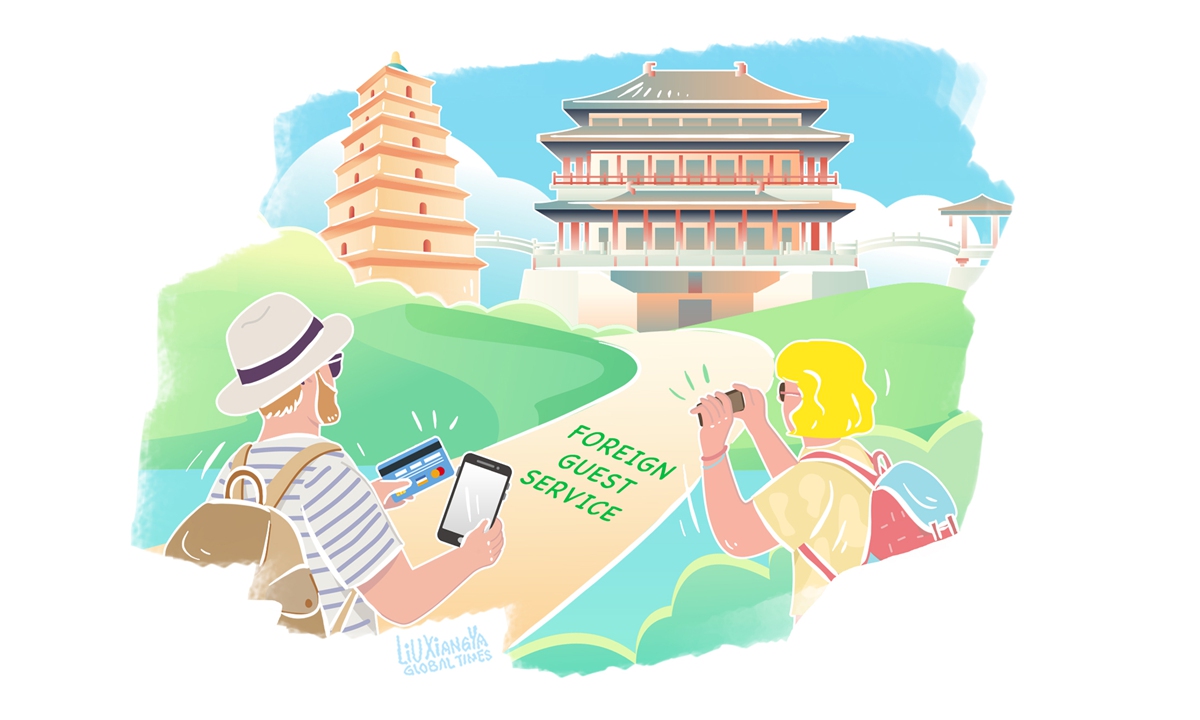
Illustration: Liu Xiangya/Global Times
Multilingual guidebooks to scenic spots, volunteers in red vests who help tourists exchange currency… China is not only well known for its natural scenic spots and rich cultural heritage but also treating foreign tourists with more hospitality and lovely, kind smiles from people who are ready to offer help to make their trips more convenient. Through multilingual services, the enhancement of travel facilities and the hands-on support of volunteers, it is fueling the “China Travel” trend, making visiting the country more accessible and enjoyable for visitors from all corners of the globe.
One of the most significant indicators of this trend is the recent measures taken to improve the overall travel experience for foreign tourists. For instance, in the Xishuangbanna Dai autonomous prefecture, Southwest China’s Yunnan Province, the local government announced on Monday a bilingual travel guide that will serve as a comprehensive resource for both Chinese and international visitors. The guide will be meticulously translated by seasoned professionals to ensure accuracy and cultural relevance, showcasing China’s commitment to making travel easier and more informative for non-Chinese speakers.
This effort aligns perfectly with the broader picture. Liu Haitao, a senior official of the National Immigration Administration (NIA), highlighted the explosive popularity of “China Travel” online at the press conference on Monday, emphasizing how foreign tourists are witnessing firsthand a confident, open, and modern China, as reported by the Xinhua News Agency. The numbers back up this claim: From January to July, 17.25 million foreign visitors entered China, marking a 129.9 percent increase compared with the previous year. He noted that further policies will also be carried out to increase convenience and broaden the scope of visa-free entry in the future.
Cities across China are embracing this wave of international tourism with targeted initiatives. In Suzhou, the local government has launched a series of measures to facilitate foreign visitors’ stays, leading to a 75 percent increase in international overnight visitors in the first half of the year. The city has equipped its cultural and tourist sites with multilingual translation devices, established multiple service points, while providing foreign currency exchange services in key tourist areas. These efforts have transformed Suzhou into a model city for international tourism in China.
Similar strides are being made in Beijing, where the “BEIJING PASS” has been introduced as an all-in-one solution for foreign tourists. This card not only covers public transportation across the city but also works at major tourist attractions, allowing seamless access to places like the Summer Palace and the Great Wall. Taishan Mountain in East China’s Shandong Province has also introduced travel guides in English, providing guidance on climate, transportation, food and the city mascot so as to make travel more convenient for foreign tourists.
China’s infrastructure improvements extend beyond physical facilities to include personal, human connections. In Beijing, volunteers like those at the Beijing South Railway Station’s bus hub provide invaluable assistance to foreign travelers. The story of Lu Qinghong, a volunteer in a red vest who helped a Venezuelan tourist navigate the city in English, exemplifies the warm and supportive environment that China offers to its guests. Through multilingual communication and genuine care, these volunteers are the embodiment of China’s hospitality.
This welcoming atmosphere is further enhanced by initiatives such as the strategic recruitment of multilingual tour guides in Xi’an, Northwest China’s Shaanxi Province, where the demand for foreign language services has been met with a robust response. By hiring guides fluent in languages like Russian and English while providing comprehensive services that allow foreign credit cards to be used in e-pay systems in China, Xi’an ensures that foreign visitors can fully engage with the region’s breathtaking landscapes and rich cultural heritage without language barriers.
The efforts also extend to ensuring that foreign visitors have access to modern amenities and services. The recent policy released by the Ministry of Commerce and six other departments focuses on improving accommodation services for foreign nationals. This includes removing unnecessary barriers for lodging operators and providing specialized training for receptionists, ensuring that all visitors, whether in China for tourism, work, or other purposes, receive top-notch service.
By combining facilities, multilingual services, and a culture of warmth and inclusion, the “China Travel” trend is inviting tourists from all over the world with more accessibility than ever before. This initiative is not just about welcoming tourists; it’s about showcasing the best of what China has to offer – its beauty, its culture, and its people.
The author is a reporter with the Global Times. life@globaltimes.com.cn










